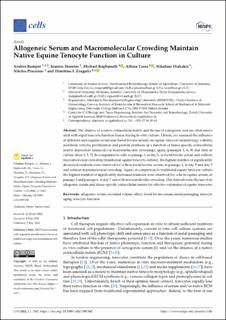Please use this identifier to cite or link to this item:
https://doi.org/10.21256/zhaw-26891| Publication type: | Article in scientific journal |
| Type of review: | Peer review (publication) |
| Title: | Allogeneic serum and macromolecular crowding maintain native equine tenocyte function in culture |
| Authors: | Rampin, Andrea Skoufos, Ioannis Raghunath, Michael Tzora, Athina Diakakis, Nikolaos Prassinos, Nikitas Zeugolis, Dimitrios I. |
| et. al: | No |
| DOI: | 10.3390/cells11091562 10.21256/zhaw-26891 |
| Published in: | Cells |
| Volume(Issue): | 11 |
| Issue: | 9 |
| Page(s): | 1562 |
| Issue Date: | 5-May-2022 |
| Publisher / Ed. Institution: | MDPI |
| ISSN: | 2073-4409 |
| Language: | English |
| Subjects: | Allogeneic serum; Excluded volume effect; Foetal bovine serum; Serial passaging; Tenocyte aging; Tenocyte function; Animal; Extracellular matrix; Horse; Macromolecular substance; Serum albumin, bovine; Hematopoietic stem cell transplantation; Tenocyte |
| Subject (DDC): | 610.28: Biomedicine, biomedical engineering |
| Abstract: | The absence of a native extracellular matrix and the use of xenogeneic sera are often associated with rapid tenocyte function losses during in vitro culture. Herein, we assessed the influence of different sera (equine serum and foetal bovine serum) on equine tenocyte morphology, viability, metabolic activity, proliferation and protein synthesis as a function of tissue-specific extracellular matrix deposition (induced via macromolecular crowding), aging (passages 3, 6, 9) and time in culture (days 3, 5, 7). In comparison to cells at passage 3, at day 3, in foetal bovine serum and without macromolecular crowding (traditional equine tenocyte culture), the highest number of significantly decreased readouts were observed for cells in foetal bovine serum, at passage 3, at day 5 and day 7 and without macromolecular crowding. Again, in comparison to traditional equine tenocyte culture, the highest number of significantly increased readouts were observed for cells in equine serum, at passage 3 and passage 6, at day 7 and with macromolecular crowding. Our data advocate the use of an allogeneic serum and tissue-specific extracellular matrix for effective expansion of equine tenocytes. |
| URI: | https://digitalcollection.zhaw.ch/handle/11475/26891 |
| Fulltext version: | Published version |
| License (according to publishing contract): | CC BY 4.0: Attribution 4.0 International |
| Departement: | Life Sciences and Facility Management |
| Organisational Unit: | Institute of Chemistry and Biotechnology (ICBT) |
| Appears in collections: | Publikationen Life Sciences und Facility Management |
Files in This Item:
| File | Description | Size | Format | |
|---|---|---|---|---|
| 2022_Rampin-etal_Native-equine-tenocyte-function-in-culture_Cells.pdf | 17.51 MB | Adobe PDF |  View/Open |
Show full item record
Rampin, A., Skoufos, I., Raghunath, M., Tzora, A., Diakakis, N., Prassinos, N., & Zeugolis, D. I. (2022). Allogeneic serum and macromolecular crowding maintain native equine tenocyte function in culture. Cells, 11(9), 1562. https://doi.org/10.3390/cells11091562
Rampin, A. et al. (2022) ‘Allogeneic serum and macromolecular crowding maintain native equine tenocyte function in culture’, Cells, 11(9), p. 1562. Available at: https://doi.org/10.3390/cells11091562.
A. Rampin et al., “Allogeneic serum and macromolecular crowding maintain native equine tenocyte function in culture,” Cells, vol. 11, no. 9, p. 1562, May 2022, doi: 10.3390/cells11091562.
RAMPIN, Andrea, Ioannis SKOUFOS, Michael RAGHUNATH, Athina TZORA, Nikolaos DIAKAKIS, Nikitas PRASSINOS und Dimitrios I. ZEUGOLIS, 2022. Allogeneic serum and macromolecular crowding maintain native equine tenocyte function in culture. Cells. 5 Mai 2022. Bd. 11, Nr. 9, S. 1562. DOI 10.3390/cells11091562
Rampin, Andrea, Ioannis Skoufos, Michael Raghunath, Athina Tzora, Nikolaos Diakakis, Nikitas Prassinos, and Dimitrios I. Zeugolis. 2022. “Allogeneic Serum and Macromolecular Crowding Maintain Native Equine Tenocyte Function in Culture.” Cells 11 (9): 1562. https://doi.org/10.3390/cells11091562.
Rampin, Andrea, et al. “Allogeneic Serum and Macromolecular Crowding Maintain Native Equine Tenocyte Function in Culture.” Cells, vol. 11, no. 9, May 2022, p. 1562, https://doi.org/10.3390/cells11091562.
Items in DSpace are protected by copyright, with all rights reserved, unless otherwise indicated.